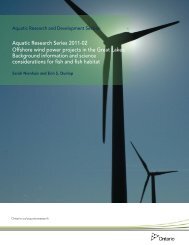Report of Research, Field Investigation and Survey of Robert D ...
Report of Research, Field Investigation and Survey of Robert D ...
Report of Research, Field Investigation and Survey of Robert D ...
You also want an ePaper? Increase the reach of your titles
YUMPU automatically turns print PDFs into web optimized ePapers that Google loves.
Apparently the issue <strong>of</strong> bending the road allowance was not part <strong>of</strong> the appeal, because no<br />
mention <strong>of</strong> this concept is made. This Superior Court decision was itself appealed, but the appeal<br />
was dropped following the issuing <strong>of</strong> the Bataglia decision. Since the decision by Justice<br />
Lauwers was not overturned it <strong>and</strong> since it is a Superior Court <strong>of</strong> Justice decision it st<strong>and</strong>s as the<br />
current state <strong>of</strong> the law.<br />
This decision has significant potential ramifications, because Reg’d. Plan 757 similarly has a<br />
straight-line “high water mark” with a “beach” area identified between the High Water Mark<br />
<strong>and</strong> water’s edge shown on the plan. Based on this decision, any claim by any <strong>of</strong> the beachfront<br />
lots within Reg’d. Plan 757 would essentially have no merit. There will be no need to consider<br />
the implications upon any <strong>of</strong> these subdivision lots since they are bounded by the straight line<br />
frontage <strong>of</strong> Reg’d. Plan 757.<br />
Since the concept <strong>of</strong> bending the Road Allowances below the original water’s edge contour was<br />
not challenged by the appeal, or discussed at great length by the Deputy Director, there is no<br />
direction in this matter. However, I believe that we can assume that the entire Boundaries Act<br />
decision has been overturned, meaning that the acceptance for bending the Road Allowance<br />
shown by Deputy Director Cotterill also does not have any st<strong>and</strong>ing. Furthermore, although<br />
instructive for general policy, Boundaries Act decisions do not have authority as precedent .<br />
The decision has no clear ramifications for the lots in Reg’d. Plan 779, since that plan does not<br />
show a separately delineated ‘Beach’ or other such area. However, the lots are not riparian,<br />
since the Reservation in the John Goesmann patent retained ownership to 20.12m along the<br />
shore <strong>of</strong> lot 19, Concession 7.If the lots are not riparian, how can anyone justify extending<br />
across the beach to the easterly limit <strong>of</strong> the Goesmann Reservation?<br />
Pitt, Andriet <strong>and</strong> Johnson all support the notion that entitlement to accretion is restricted by the<br />
underlying Township lines. In his submission to the Deputy Director O.L.S. Stewart claims that<br />
Alberta is unique in Canada, in that its <strong>Survey</strong>s Act gives special status to the ‘township,<br />
sections, quarter sections <strong>and</strong> legal subdivisions’. In the sections which he mentions I only see a<br />
numbering protocol <strong>and</strong> the basic technical details <strong>of</strong> the basic set up <strong>and</strong> size <strong>and</strong> direction for<br />
township structure. Elsewhere in this statute, or in other Alberta statutes there may be wording<br />
to give special status to these boundaries, but otherwise I don’t see a big difference between the<br />
Alberta version <strong>and</strong> ours, because both deal with how lines are to be set.<br />
Page 58 <strong>of</strong> 66
















